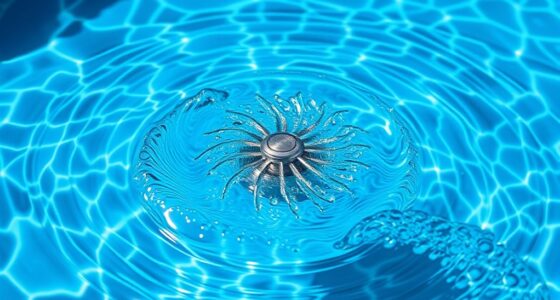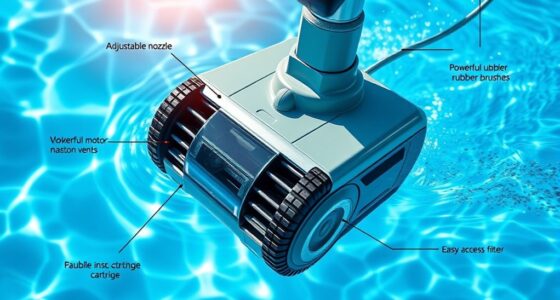Filters trap particles by forcing water or air through tiny pores or specialized media like activated carbon and mesh. As contaminants accumulate, clogging occurs, which reduces flow and may encourage bacterial growth. Regular maintenance—flushing, replacing, and monitoring flow—prevents buildup and guarantees ideal performance. Paying attention to signs like reduced flow or odors helps you know when to act. Keep going to discover simple ways to extend your filter’s lifespan and stay efficient longer.
Key Takeaways
- Filters trap particles by size, using media like paper or mesh, which physically block contaminants from passing through.
- Clogging occurs as particles, minerals, and microbes accumulate, reducing flow and filtration efficiency over time.
- Proper flow rate maintains filter performance; too fast causes bypass and damage, too slow leads to buildup and microbial growth.
- Regular maintenance, including cleaning and timely replacement, prevents clogging, odors, and microbial proliferation.
- Monitoring pressure and flow indicators helps determine when to service filters, extending lifespan and ensuring optimal filtration.
How Filters Capture Particles
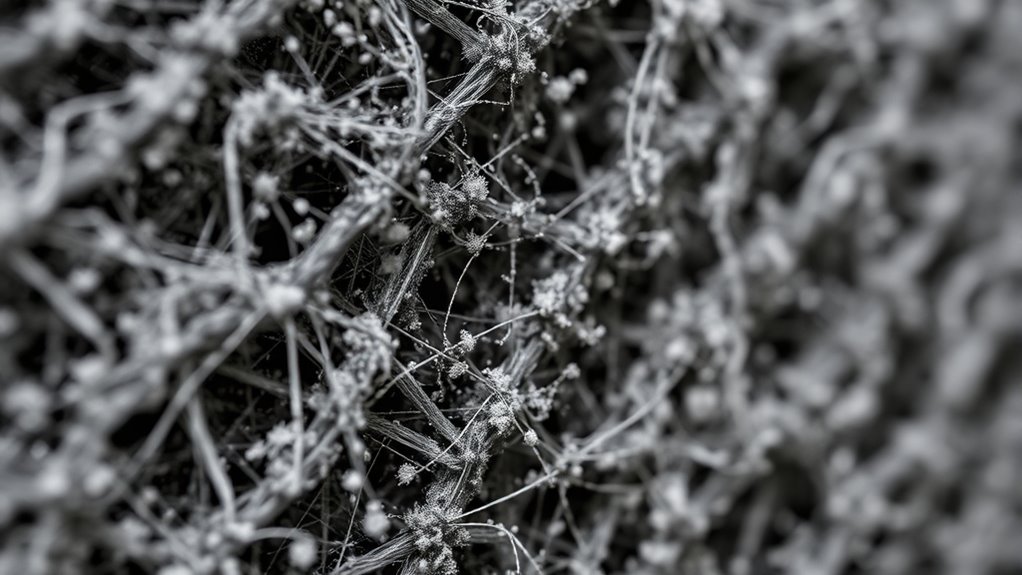
Filters capture particles through a combination of physical and mechanical processes that trap contaminants as air or liquids pass through them. One key factor is filter pore size, which determines the size of particles that can be blocked. Smaller pores catch tiny particles, while larger pores allow bigger contaminants to pass. Particle adhesion also plays a vital role; once particles come into contact with the filter surface, they stick due to electrostatic forces, moisture, or surface friction. This adhesion helps prevent particles from bouncing off or passing through the filter. As air or liquid flows through, these processes work together to effectively remove debris, dust, or other contaminants, ensuring cleaner air or fluids downstream. Understanding filter pore size and its impact on performance is essential for selecting the right filter for specific applications. Proper understanding of these mechanisms improves filter performance and longevity.
The Role of Filter Materials and Media
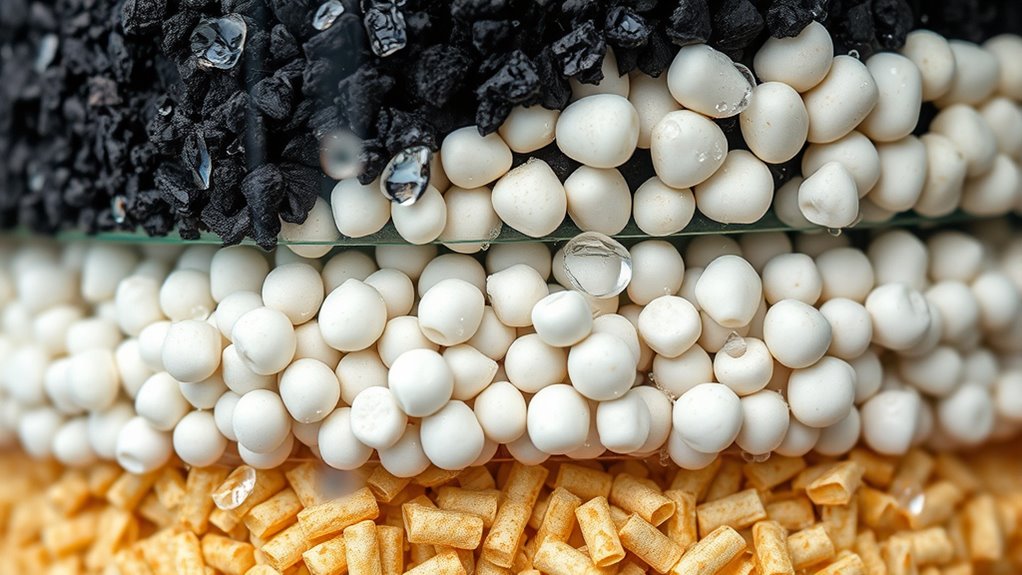
The materials and media used in filters are essential for determining their efficiency and durability. When you choose filter material, consider how well it captures contaminants and resists wear over time. Effective filter material selection ensures that particles are removed without clogging too quickly, which extends the media lifespan. Different media types, such as pleated paper, mesh, or activated carbon, serve specific functions and impact maintenance needs. High-quality materials maintain filtration performance longer, reducing the frequency of replacements. By understanding the role of filter media, you can better optimize your filter’s performance and longevity. Proper media selection not only improves filter efficiency but also minimizes waste and maintenance costs, making your filtration system more reliable and cost-effective over time. Filter material quality plays a crucial role in balancing filtration performance with maintenance requirements.
Understanding Clogging and Buildup

Understanding how clogging and buildup occur is essential for maintaining your filtration system’s efficiency. Over time, particles, minerals, and organic matter accumulate on the filter media, causing obstructions. Chemical reactions, such as mineral deposits from hard water, can worsen buildup by creating scale that sticks to filter surfaces. Environmental factors also play a role; high temperatures, humidity, and exposure to pollutants can accelerate clogging by promoting microbial growth or increasing particle load. As these elements combine, they form layers of debris that restrict flow and reduce filter performance. Recognizing these causes helps you anticipate when maintenance is needed. Additionally, choosing appropriate filter types can help minimize clogging issues and extend the life of your air purifier. By understanding the interplay of chemical reactions and environmental influences, you can better prevent unnecessary clogging and keep your filtration system running smoothly.
The Importance of Regular Flushing and Replacement
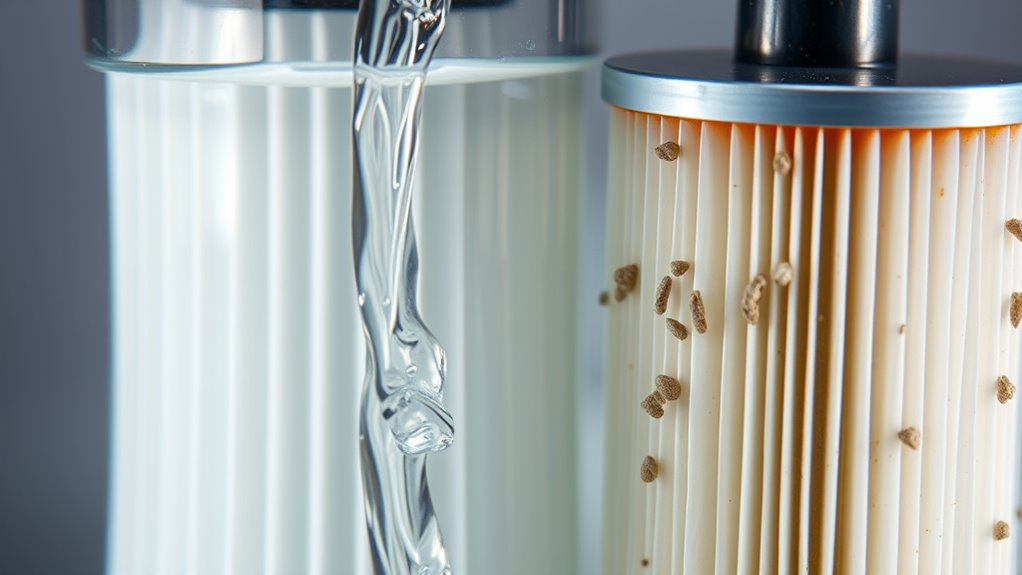
Regularly flushing and replacing your filter prevents bacterial build-up that can compromise water quality. It also keeps the filter working efficiently, ensuring ideal performance. Skipping these steps might lead to clogs and reduced filtration effectiveness. Proper filter maintenance is essential to prolong the life of your purifier and maintain optimal air quality.
Prevents Bacterial Build-Up
To effectively prevent bacterial build-up, you need to prioritize regular flushing and replacement of your filters. This process interrupts harmful biofilms and reduces organic waste, which can harbor bacteria. During biological filtration, bacteria break down waste through chemical reactions, but if filters aren’t maintained, bacteria can multiply excessively. Regular maintenance ensures these beneficial bacteria stay balanced, preventing harmful colonies from forming. Additionally, flushing removes accumulated debris, minimizing stagnant zones where bacteria thrive. By staying consistent with filter care, you support a healthy environment and reduce health risks. Remember, neglecting this step allows bacteria to flourish, compromising water quality. Keep your filters clean to sustain effective biological filtration and prevent bacterial build-up, ensuring your system remains safe and efficient. Proper filter maintenance is also essential for preserving filter longevity and maintaining optimal performance.
Ensures Filter Efficiency
Maintaining filter efficiency hinges on consistent flushing and timely replacement, as neglecting these steps can cause clogs and reduce flow rates. Regularly flushing removes accumulated debris and prevents harmful chemical interactions that could weaken filter materials. This process guarantees the filter maintains peak performance and prevents buildup that diminishes its effectiveness. Additionally, timely replacement prevents contaminants from bypassing the filter, protecting both your system and the environment. When filters are neglected, chemical interactions within the filter media can produce byproducts that harm ecosystems if released. Proper maintenance minimizes environmental impacts by ensuring contaminants are effectively captured and disposed of. Staying informed about filter material durability and following manufacturer guidelines can further enhance maintenance practices. By staying proactive with flushing and replacement, you prolong filter life, improve efficiency, and support eco-friendly practices.
How Flow Rate Affects Filter Efficiency

Maintaining the right flow rate is key to keeping your filter working effectively. If the flow is too fast, it can reduce filtration efficiency, while too slow may cause buildup and clogging. Finding that ideal range ensures your filter performs at its best without unnecessary risks. Proper tuning and performance upgrades can help optimize flow and filtration.
Optimal Flow Rate Range
Have you ever wondered how the flow rate impacts your filter’s performance? Maintaining an ideal flow rate guarantees your filter works efficiently without shortening its lifespan. When the flow rate is too high, it can cause excessive pressure, disrupting chemical reactions essential for filtration and accelerating wear. Conversely, a flow rate that’s too low may reduce the filter’s ability to trap particles effectively. The perfect range balances these factors, maximizing filtration while minimizing strain on the filter. Proper flow rate supports effective chemical reactions within the filter media. It helps extend the filter’s lifespan by preventing unnecessary stress. Consistent flow ensures efficient removal of contaminants without compromising performance. Additionally, understanding the importance of contrast ratio can help optimize overall system functionality. Staying within this range keeps your filter functioning excellently, saving you maintenance costs and ensuring cleaner results.
Too Fast, Reduced Filtration
When the flow rate is too fast, it can actually reduce the filter’s effectiveness by allowing contaminants to pass through more easily. Speed issues cause the water to move too quickly, giving particles less time to be captured. This high flow rate diminishes the filtration impact, as filters aren’t able to trap debris effectively. Instead of filtering out impurities thoroughly, contaminants slip through gaps or bypass the filter altogether. Rapid flow can also cause turbulence, disturbing the filter media and decreasing its ability to trap particles. Maintaining an ideal flow rate is essential for efficient filtration. Too fast, and you risk compromised water quality and increased maintenance needs. Ensuring proper flow allows your filter to perform at its best, capturing contaminants before they cause problems downstream. Proper air purifier operation is crucial to optimize filter lifespan and performance.
Too Slow, Buildup Risks
While a flow rate that’s too fast hampers filtration by allowing contaminants to slip through, moving too slowly can introduce its own set of problems. When flow slows, debris buildup accelerates, increasing the risk of chemical leaching from filter materials and reducing odor control. This stagnation can cause unpleasant odors to develop and compromise water quality. Additionally, slow flow rates promote bacterial growth, further degrading filter performance. You might notice a decrease in filtration efficiency and increased maintenance needs. To avoid these issues, aim for an ideal flow rate that balances effective contaminant removal with minimal buildup. Proper flow ensures your filter works efficiently, prevents chemical leaching, and maintains good odor control over time. Keep an eye on flow rates to keep your system running smoothly. Maintaining optimal flow rate is essential for ensuring long-term filter effectiveness and safety.
Preventing Bacterial and Mold Growth
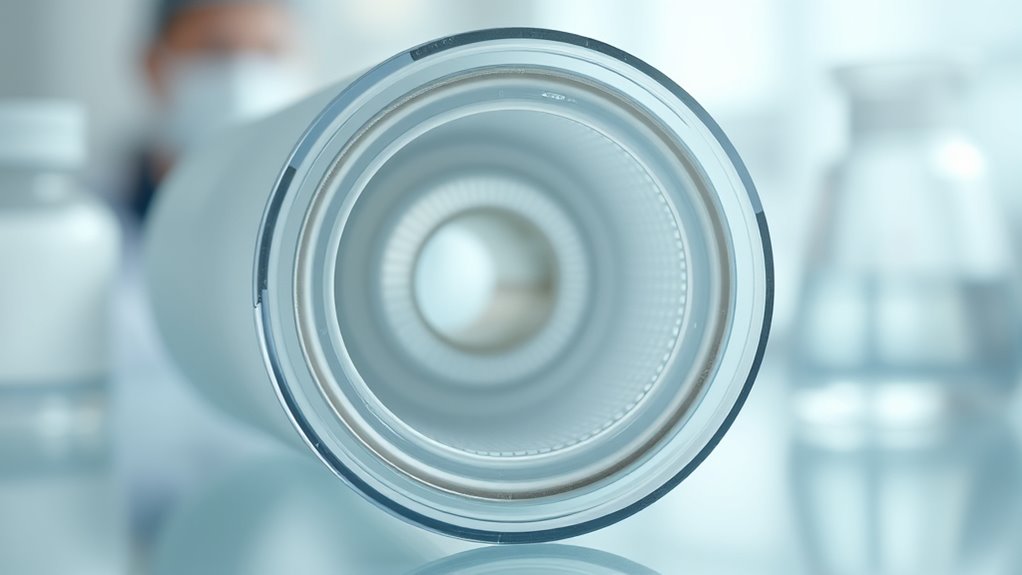
How can you effectively prevent bacterial and mold growth in filters? The key is to control moisture and promote proper air circulation, which disrupts the chemical reactions bacteria and mold need to thrive. Regularly replacing your filter reduces accumulated moisture and organics that support growth. Ensuring good air flow prevents stagnant spots where mold develops. Consider using antimicrobial treatments if applicable, but avoid overuse, as it can affect chemical reactions on the filter surface. Maintain a dry environment and check your filter often. Here’s a quick guide:
| Tip | Why it helps |
|---|---|
| Change filters regularly | Removes buildup that promotes growth |
| Improve air circulation | Prevents stagnant moisture where mold thrives |
| Keep environment dry | Limits moisture necessary for bacteria growth |
| Use antimicrobial agents | Reduces bacteria and mold spores |
| Monitor humidity levels | Keeps air dry enough to inhibit growth |
Signs That Your Filter Needs Maintenance
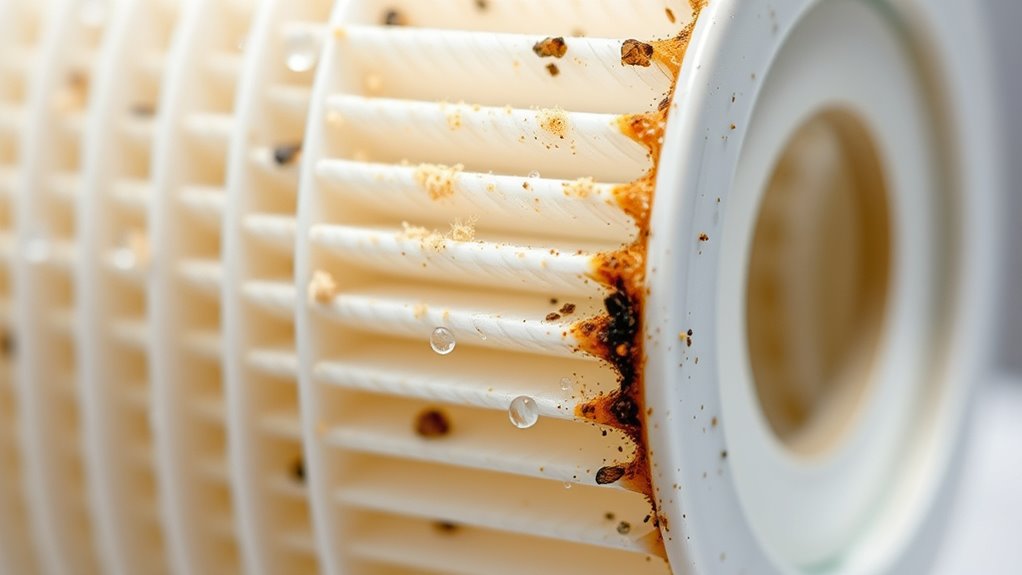
Noticing changes in your filter’s performance is a clear sign it needs maintenance. Over time, chemical reactions within the filter can cause it to clog or become less effective, shortening its filter lifespan. When your filter isn’t functioning properly, you might observe specific signs:
- Reduced water flow or increased pressure
- Unusual odors or discoloration in the filtered water
- A visible buildup of debris or sediment on the filter surface
These indicators suggest that buildup from chemical reactions or contaminants is impairing the filter’s ability to operate efficiently. Ignoring these signs accelerates deterioration and decreases lifespan, making maintenance crucial. Regularly checking for these signs ensures your filter continues to perform at its best and prevents costly replacements.
Tips for Extending Filter Lifespan
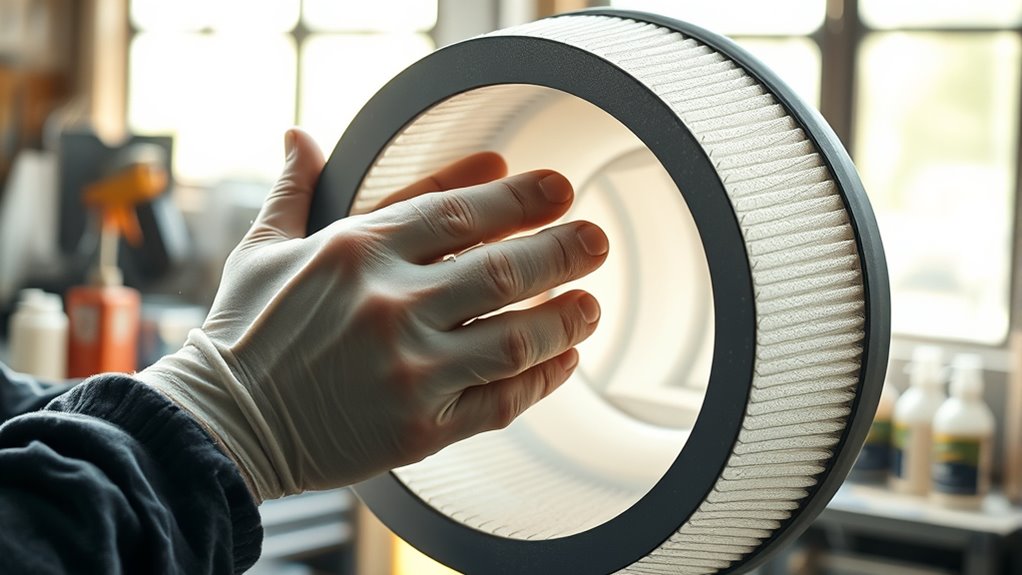
Maintaining your filter properly can greatly extend its lifespan and guarantee ideal performance. To do this, focus on optimizing filter material durability through regular cleaning and timely replacements. Follow a consistent maintenance scheduling plan based on your filter’s usage and manufacturer recommendations. Avoid neglecting your filter, as dirt buildup can reduce its efficiency and cause damage over time. Proper maintenance helps preserve the integrity of the filter material, ensuring it continues to perform effectively. Keep an eye on performance indicators like pressure drops or flow rates, which can signal when cleaning or replacement is needed. By staying proactive and sticking to a maintenance schedule, you’ll maximize your filter’s lifespan, save money, and maintain the quality of your system’s output.
Frequently Asked Questions
How Do Temperature Changes Affect Filter Performance?
Temperature changes can impact your filter’s performance by causing thermal expansion, which may lead to deformation or cracks. When temperatures fluctuate, materials can degrade faster, reducing filter efficiency and lifespan. You should regularly check your filter, especially during extreme weather, to guarantee it remains effective. Proper maintenance helps prevent material degradation and maintains ideal filtration, so your system continues operating smoothly despite temperature variations.
Can Filter Maintenance Improve Energy Efficiency?
Yes, filter maintenance can considerably improve energy efficiency, acting like a well-tuned engine. When you keep filters clean, airflow optimization occurs, reducing the strain on your system. This not only extends the filter lifespan but also ensures your system runs smoothly without overworking. Regular maintenance prevents blockages, lowers energy consumption, and saves you money in the long run. Keep your system in top shape, and it’ll run like a dream!
What Are the Environmental Impacts of Discarded Filters?
Discarded filters can harm the environment if not properly managed. You can reduce this impact by supporting recycling strategies and choosing filters made from eco-friendly materials. Recycling helps prevent filters from ending up in landfills, where they can release pollutants. Opting for eco-conscious options minimizes waste and promotes sustainability. By properly disposing of filters and encouraging eco-friendly materials, you contribute to protecting ecosystems and reducing your carbon footprint.
Are There Filters That Require Less Frequent Maintenance?
Yes, some filters have a longer lifespan and require less frequent maintenance. High-quality HEPA filters, for instance, often last several months to a year before needing replacement, reducing maintenance frequency. Additionally, washable filters can be reused multiple times, cutting down on disposal and upkeep. By choosing filters with extended lifespans, you can enjoy cleaner air with less hassle and less environmental impact.
How Does Filter Design Influence Ease of Cleaning?
While a gentle nudge might suggest some filters are easier to maintain, the design truly influences your cleaning experience. Opt for filter materials that are accessible and durable, making cleaning techniques straightforward. Features like removable, washable components and smooth surfaces reduce hassle, allowing you to clean efficiently without fuss. Good design minimizes buildup and simplifies upkeep, so you spend less time maintaining and more time enjoying the fresh air or clean water you deserve.
Conclusion
Think of your filter as the lungs of your system—when kept clean, it breathes easily and works efficiently. I once ignored my filter, and clogged buildup caused my system to strain, like trying to breathe through a blocked straw. Regular maintenance keeps your filter running smoothly, preventing costly repairs. Just like a well-maintained engine, your system performs best when you give it the care it needs. Stay proactive, and enjoy clean, efficient operation.


